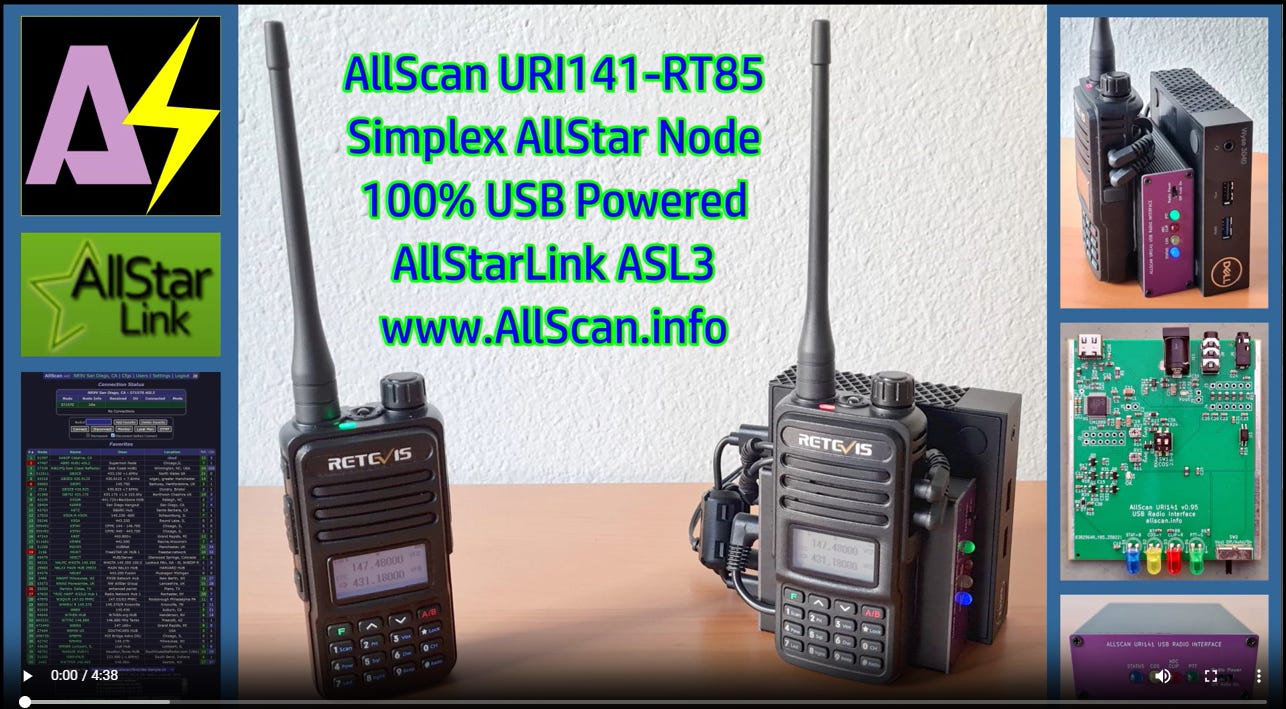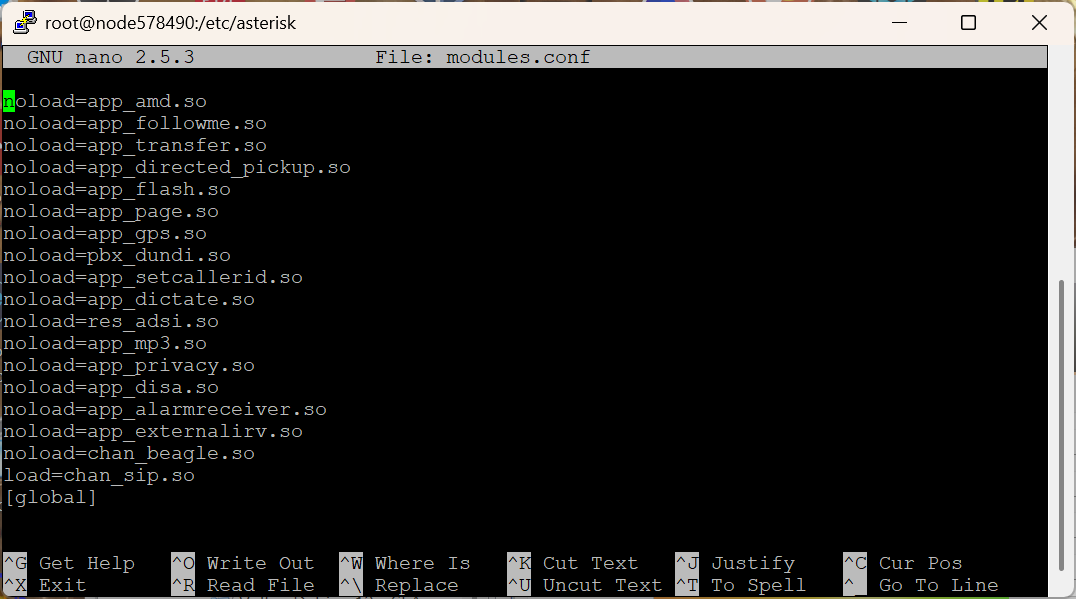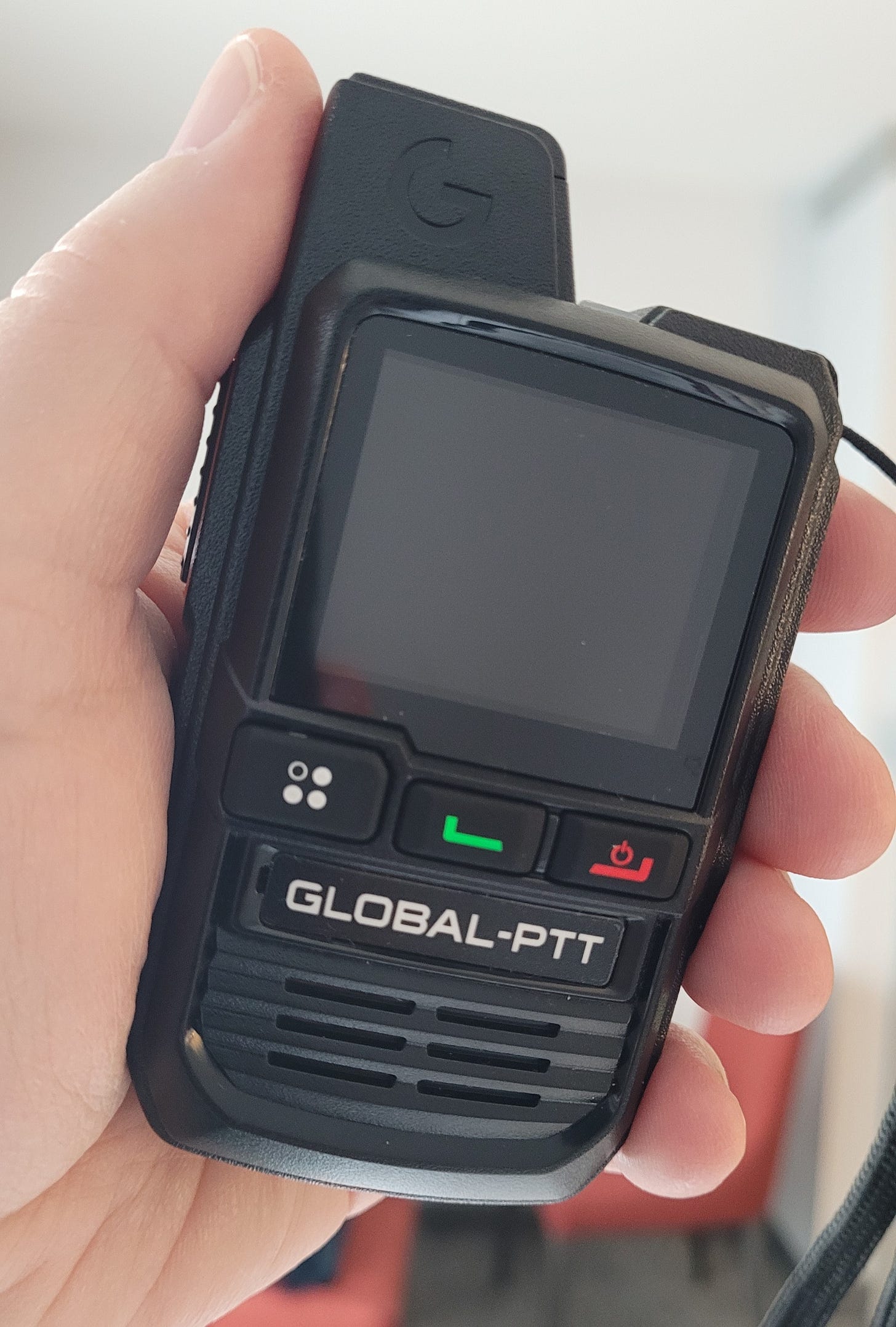Random Wire Review: Issue 124
March 19, 2025: This issue is mainly about AllStar nodes but also included are some links to other interesting newsletters. I'm testing some new gadgets, too.
On the road again
I’m on the road again this week, with a trip to Olympia and three days in Ocean Shores, Washington. Issue 124 is publishing a few days early so I can concentrate on my business meeting. Because I’ve been traveling, I’ve been using my Hamshack Hotline connection to my node-in-the-cloud 57945 and also listening to nets while I drive with a Web Transceiver connection through DVSwitch Mobile. It is great to have options!
1. New AllStar node is coming!
I’m excited to be getting a new node soon from David Gleason NR9V, the AllScan ANH100 Half-Duplex AllStar Node. This package includes a Dell Wyse 3040 Mini PC, the AllScan URI141 URI, and a Retevis RT85 HT radio.
Check out the demonstration video on the AllScan.info website for more about this product.
As David and I conversed about it, I realized I’d be happier with the URI150 as it supports a bit more power, so I requested the upgrade to the URI150.
You might notice in the screen grab above that there is a difference in signal-to-noise ratio between the node with the URI141 and the upgraded node with the URI150. You might not think this is significant, but a 47 decibel SNR means the signal is 54 times stronger than the noise present, while a 60 dB SNR presents a signal that is 1,000 times stronger than the noise.
What this may mean for me is much better audio clarity with the URI150-based node in my noisy RF-rich environment. The new node should arrive next week and I’m looking forward to putting into service.
But hold the phone! David just informed me he’s done some additional optimization and tuning to the URI141 node and it is now on par with the URI150-based node! What an incredible value!
By the way, the Retevis RT85 handheld radio is a great value, in my opinion. I have a couple of them and find them easy to use with good audio quality. How about a pair for $40? The low price point makes this a must-have radio, if only as a backup radio.
2. ClearNode 578490 modifications & TechNote
My ClearNode from Node-Ventures.com started life a few years ago as node 57849 but when I needed more node numbers, I extended the node, creating several additional “NNX” numbers at AllStarLink.org. Thus, node 57849 is now node 578490.
Node 578490 runs the HamVoIP version of AllStar on an ASL 2 base. I published a how-to on connecting this version of the ClearNode to a SIP phone in TechNote #7.
Thank you to Gerry Filby of Node-Ventures.com for pointing out the need to modify a template file, because otherwise my custom configuration would be overwritten from the template each time the node updated!
I also replaced the stock antenna with a 440-MHz flexible whip by SignalStuff. This $22 antenna looks good and is working well with the node.
I also modified the sound settings for the ClearNode using information gleaned from a ClearNode Groups.io thread published in May 2024: https://groups.io/g/ClearNode/topic/optimizing_clear_node_audio/105959207. Those changes do make the audio coming through the ClearNode sound better to me.
3. Virtual machine node 588411 resurrected
Node 588411 running in a virtual machine powered by VirtualBox has been powered down for a few months. I’ve installed some updates on my Windows 11 server in the meantime, and at some point, something changed (it was the firewall). When I restarted the node, I found I had 79 updates to install in Debian 12!
After I got the node updated and running again, I noticed I couldn’t connect to nodes inside my LAN and not to nodes out in the big wide world. I checked my ports: all looked fine. I checked my port forwarding rules on my router: all good. I checked the UFW (Uncomplicated Firewall) settings on my node and found a different port number than I expected, so I fixed that and reloaded it. I still couldn’t make connections.
So I did what most of us would do: I rebooted the node. (Isn’t it amazing how a reboot often solves most problems?) That didn’t resolve it. As I sat and thought about this, I began to wonder if the VirtualBox virtual machine had its own firewall. Some internet searching said no, when the VM is set to use network address translation (NAT) for the virtual adapter, the VM uses the Windows firewall.
Ah. So it uses the host machine’s firewall.
I went and looked at the Windows Defender Firewall inbound rules. There were no port rules matching my AllStarLink/Asterisk settings. I added the inbound rules…and still couldn’t make connections.
Surely, I thought, outbound connections are allowed by default. No, they were not. I added the same outbound rules as I did for the inbound rules, then restarted the node again. This time, it all worked just as it should.
4. Node 588415 misbehaved
My AllStar node 588415 is installed on a Dell OptiPlex 7050 Micro, running Debian 12 and AllStarLink 3. I needed to change the BIOS so that this node would automatically restart whenever my office power went out and then resumed. Losing power at that location happens more often than I would like, so much so that I ought to use an uninterruptible power supply for that node.
To change the BIOS, I brought my portable ViewSonic monitor (purchased in September 2022) to the office and hooked it up with a DisplayPort-to-HDMI adapter.
That did not work. The Dell probably needs an active Display Port-to-HDMI adapter (I touched on active adapters in Random Wire issue 114). When I took a more careful look at the back panel of the 7050, I saw an HDMI port. Perfect. Once I went straight from the HDMI to the mini-HDMI input on the monitor, the portable monitor worked fine.
Then I struggled a bit with getting the 7050 to boot to the BIOS. Various pundits said things like: press the F2 key repeatedly during bootup to get to the BIOS, or press the F12 key repeatedly. Nope. Finally, I resorted to bashing away at the ESC key during the boot sequence until I saw a prompt that would let me select the BIOS settings.
Once there, changing the Power Management setting to restart when power resumed was quick and easy.
However, somewhere along the way (by now we’re talking about around 20 reboots of the machine to get to this point), I did something that caused the reboot sequence to hang up on something called the cups-browsed.service. (I think this happened during one of the escape-key bashing sessions.) That service was waiting 90 seconds before it would allow the shutdown process to continue. Since I don’t have any printers on this machine, I disabled that service. Smiling, I rebooted, assuming this would resolve that problem.
sudo systemctl disable cups-browsed.serviceI was no longer smiling when that did not solve the problem.
More web searching revealed that I could simply edit a file to change the timeout setting:
sudo systemctl edit cups-browsed.service Once that file was open, I added a new section:
[Service]
TimeoutStopSec=5After saving the change, I reloaded the system daemon:
sudo systemctl daemon-reload When I tested this by issuing a “sudo shutdown now” command, the shutdown process flashed by very quickly. Yay!
To complete my testing, I booted up again, and then pulled the power plug from the machine. After waiting several seconds, I plugged it back in and the machine restarted automatically, just as I had set it to do in the BIOS.
5. Garuda Linux
After reading an article titled Garuda Linux Might Be the Best Looking Desktop OS on the Market, I loaded up an ISO of that release in a VirtualBox virtual machine. Running Garuda Linux (which is based on Arch Linux, so not as friendly as Debian and Ubuntu flavors of Linux) in a VM is not recommended. Garuda uses more resources than some Linux versions, particularly on the graphics side.
But oh my, what a beautiful release it is! Even though it ran slowly in my VM, I could tell it was worth exploring. I may dig out an older laptop and try installing it if the onboard graphics card will handle the load.
Learn more at: https://garudalinux.org/
6. Other Substacks and more
My favorite amateur radio Substack is the Zero Retries newsletter by Steve Stroh N8GNJ. While I’m banging away at old computers to see if I can make them do things I want them to do, Steve is exploring cutting edge topics, some of which I’ve never heard of. I’m amazed with every issue of Zero Retries.
I do keep an eye on some other amateur radio Substack publications.
Ria’s Ham Shack by Ria Jairam N2RJ. She has an interesting podcast posted on March 10th titled Antenna tuners aren’t bad.
73 from G5DOC by Christian Payne G5DOC. His About page describes a pathway many of us have taken, starting with a CB radio and moving to other platforms. Like me, he operates mobile some of the time. Unlike me, he takes it much farther!
You might also be interested in content that is about technology, science, or radio, even if it isn’t exactly amateur radio.
National Communications Magazine is a paid publication but still has some free content that is interesting. For example: “Whistler’s factory is back in business producing scanners once more!”
ByteByteGo Newsletter usually has something that interests me from a technology perspective. A good place to start is The Best of the ByteByteGo Newsletter.
ScienceDaily always has something that piques my interest. For example, check out ScienceDaily: Technology - March 10, 2025.
And with my background as a geologist working in gold mines and exploring for precious metals, I appreciate some good geologic content.
The Geologic Column covers a wide range of earth science topics but there is a distinct leaning toward minerals and tectonics.
Mineral Matters is all about minerals, with some great photographs. Based in Australia, the author offers views of the mineral world that many of us would never see.
There is also content on Medium.com. I recently joined Medium and am exploring it both as a publication medium and as someone who enjoys reading a wide range of content. Substack’s strength is the long-form content style and automatic delivery via email to subscribers. Medium’s strength is the wide range of content available, sometimes in long form and sometimes in shorter chunks. There are a number of amateur radio operators who publish on Medium.
N2RAC | DU2XXR: Amateur Radio and Communications specializes in emergency preparation.
Tango Foxtro Wireless Society HB9TF is based in Zurich, Switzerland. The Society is open for local and international memberships, serving as a “home to a group of renaissance HAM radio enthusiasts with computer science and electrical engineering backgrounds.” They have a WIRES-X repeater, a FlexRadio 6700 club station, and more. One of their WIRES-X systems (DTMF ID 44074) is in Muottas Muragl, an incredibly beautiful location.
Radio Hackers is a joy to read. I particularly enjoyed a two-part series, starting with Python Radio 33: FM—No Static At All and concluding with Python Radio 34: Immaculate Reception. These two stories are only available to Medium members.
The takeaway I want to share with you is simply this: why not keep exploring? Maybe it’s radio that lights your mind, or maybe it is some other topic. There is a huge amount of content available if you’re willing to poke around. For me, finding a new source that intrigues me is a wonderful discovery.
7. Gadgets!
Bluetooth speaker
On a whim, I picked up this device on sale on Amazon:
I really like this thing. It’s small, has plenty of volume, and the audio quality coming out of the little speaker is amazingly good. It is water resistant, lightweight, has a long battery life, and clips to your pocket or jacket.
I’ll continue to test it over the next several weeks to make sure it is durable enough to get the coveted Random Wire Recommended sticker. What I can say early in this process is this: I like it so much I bought a second one!
KVM switch
I have computers in multiple locations, some hundreds of miles away. To manage them, I have been using Windows Remote Desktop on my Windows 11 laptop, but I’m always looking for a better way.
In my primary location, I have dozens of computing devices running, so the ability to share a keyboard, monitor, and mouse would be a handy addition to my tech stack. I’ve tried a few KVM switches before but I have not liked them. I’m hoping this one from router maker GL.iNET works better, so I pre-ordered one unit for $69. I should arrive around the middle of April. Fingers crossed.
Cellular walkie talkies
I’m giving a pair of cellular walkie talkies a test while I travel. My spouse and daughter are not licensed hams so this push-to-talk style of communication over 4G networks may (I hope) help us keep in touch. The battery life appears to be very good and that is an important feature when folks on the other end forget to charge their smartphone!
In my shopping, this pair of radios for $177 (after clipping the 15% coupon) provided a good balance between cost and positive reviews. I’m hopeful these rugged little devices will be winners.
8. Musings
Chaos
One of my favorite science books of all time is titled Chaos: Making of a New Science. When I first read this book, I was working as a geologist in a fascinating underground gold mine, with narrow quartz veins that twisted and bent, this way and that, through the rocks surrounding them. The veins seemed very disordered and unpredictable, but I soon saw patterns that were similar across different scales: fractured wall rock millimeters from veins and fractures several meters from veins; cauliflower-like textures under the microscope that were also expressed macroscopically from several feet away; and many other physical characteristics of the veins and the rocks they were contained within.
What I was seeing was fractal patterns expressed across different scales, from very tiny to quite large. That book helped me identify what I was seeing. I could put a name to it. I could almost understand it. I even calculated the fractal dimension of various parts of the vein system, but that’s another story altogether.
When I saw an article in Phys.org titled Why does nature love spirals? The link to entropy, I felt an immediate deja vu moment from my discovery of fractal geometry. The article took me back to my mining days because it was expressing — in short form — some views of patterns and harmony in the natural world that the book had suggested in long form.








I run Garuda on my gaming PC hardware, but for my old re-furbished Acer Chromebook, I run EndeavorOS. It's also based on Arch. I used to run Ubuntu on the desktop and Debian on the Chromebook, but once I got used to Arch (Garuda and Endeavor both make it easy) I haven't looked back. The ham radio software packages are way more up to date than the versions you get on Ubuntu and Debian.